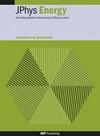Roll-to-roll double side electrode processing for the development of pre-lithiated 80 F lithium-ion capacitor prototypes
IF 6.3
3区 材料科学
Q1 ENERGY & FUELS
引用次数: 0
Abstract
Abstract Lithium-ion capacitors (LICs) show promise to help lithium-ion batteries (LIBs) and electrical double layer capacitors (EDLCs) in giving response to those applications that require an energy storage solution. However, pre-lithiation is a major challenge that needs to be tackled in order to develop efficient and long-lasting LIBs and LICs. In this work, we report for the first time the scale-up and utilization of sacrificial salts (dilithium squarate, Li 2 C 4 O 4 ) as a pre-lithiation strategy in a LIC prototype fabricated in a pilot line. The synthesis of the sacrificial salt is scaled-up to produce 1 kg and is later incorporated in the positive electrode during the slurry formulation. After in-depth process optimization, 12 meter of a double side electrode are fabricated, achieving a high mass loading of 5.5 mg cm −2 for the HC negative electrode, and 14 mg cm −2 for the positive electrode accounting both the activated carbon and the dilithium squarate. On account of the satisfactory mechanical and electrochemical behaviour of the electrodes, multilayer pouch cell LIC prototypes are fabricated reaching 80 F each. Pre-lithiation is completed during the first ten cycles and after the required gas exhaustion, electrochemical performance of prototypes is also satisfactory. Moreover, fabricated pouch cells overcome a float test of 1600 h at 50 °C showing a capacitance retention of 84.3%. These results give clear evidence for the potential use of this strategy in real products and can foster research in the field to promote pre-lithiation by means of sacrificial salts as the final solution to the pre-lithiation step, both for LIBs and LICs.用于开发预锂化80 F锂离子电容器原型的卷对卷双面电极加工
锂离子电容器(lic)有望帮助锂离子电池(lib)和电双层电容器(edlc)响应那些需要储能解决方案的应用。然而,为了开发高效、持久的锂离子电池和锂离子电池,预锂化是一个需要解决的重大挑战。在这项工作中,我们首次报道了牺牲盐(方二锂,Li 2c4o4)作为预锂化策略在中试生产线上制造的LIC原型中的扩大和利用。牺牲盐的合成按比例放大到生产1千克,然后在浆液配方期间纳入正极。经过深入的工艺优化,制备了12米长的双面电极,其中HC负极的质量负载为5.5 mg cm - 2,正极的质量负载为14 mg cm - 2,同时考虑了活性炭和平方二锂。由于电极的力学和电化学性能令人满意,制作了每个达到80华氏度的多层袋状电池LIC原型。预锂化在前10次循环中完成,在所需气体耗尽后,原型的电化学性能也令人满意。此外,制备的袋状电池克服了在50°C下1600小时的浮子测试,显示电容保持率为84.3%。这些结果为该策略在实际产品中的潜在应用提供了明确的证据,并可以促进该领域的研究,以牺牲盐作为lib和lic预锂化步骤的最终解决方案来促进预锂化。
本文章由计算机程序翻译,如有差异,请以英文原文为准。
求助全文
约1分钟内获得全文
求助全文
来源期刊

Journal of Physics-Energy
Multiple-
CiteScore
10.90
自引率
1.40%
发文量
58
期刊介绍:
The Journal of Physics-Energy is an interdisciplinary and fully open-access publication dedicated to setting the agenda for the identification and dissemination of the most exciting and significant advancements in all realms of energy-related research. Committed to the principles of open science, JPhys Energy is designed to maximize the exchange of knowledge between both established and emerging communities, thereby fostering a collaborative and inclusive environment for the advancement of energy research.
 求助内容:
求助内容: 应助结果提醒方式:
应助结果提醒方式:


